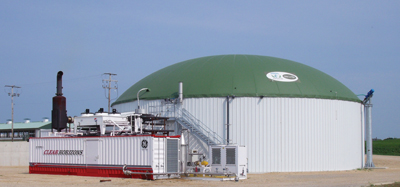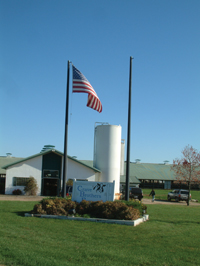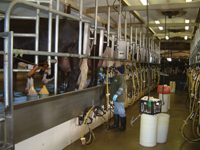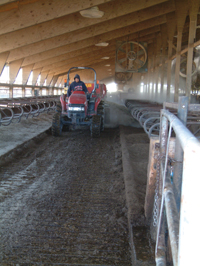
Not only does Crave Brothers Dairy Farm in Wisconsin have contented
cows, it also has contented cow owners – four of them in fact, all
responsible for various aspects of the 1,100-head dairy, 1,700-acre
farm, and cheese factory.
Not only does Crave Brothers Dairy Farm in Wisconsin have contented cows, it also has contented cow owners – four of them in fact, all responsible for various aspects of the 1,100-head dairy, 1,700-acre farm, and cheese factory.
 |
| The Crave Brothers biogas installation was the first one for Clear Horizons although the company is currently constructing an even larger project in Dane County, Wisconsin, which will be fed manure provided by three separate dairy farms. Contributed photo |
That’s because of the minimal risk they have taken on in a partnership with Clear Horizons LLC, a biogas-to-energy company headquartered in Milwaukee, Wisconsin. Clear Horizons has provided a turnkey solution to convert its manure into biogas for power generation, solids into compost for bedding, and a steady stream of nutrient-rich manure liquids that the dairy uses for crop irrigation.
The dairy generates about 60,000 gallons of manure per day, and that includes whey from its cheese factory.
“The biggest motivation for us to adopt anaerobic digestion was to be able to separate our manure, have less smell, and be able to apply the liquid manure to the land, which is more suitable for crop needs than raw manure,” says Tom Crave. He looks after the dairy farm’s crop operations. “We thought about it for about three years because it is a big investment. Over that three-year period, we were able to work with this company where they actually own the digester. So it was a decision made easier because we didn’t have to invest in it.”
 |
|
The Crave Brothers dairy operation consists of two sets of buildings – one set of three buildings for milking cows and a second set for heifers and dry cows.
Photo by Margaret Land |
 |
|
The Craves’ operation involves 1,100 head of milk cattle, which supply 80 percent of the milk to the family’s nearby cheese operation.
Photo by Margaret Land
|
With the manure stream and odor situation under control, Charles, Thomas, Mark and George Crave can concentrate on their other ventures, producing milk and making a variety of cheese products for both the domestic and international markets. About 80 percent of the milk the dairy produces goes into cheese production.
All the dairy is providing Clear Horizons is a steady stream of manure and a plot of land, while the bioenergy company has invested $3 to $4 million in the collection, anaerobic digestion, and compost storage infrastructure. The Crave Brothers installation, located about an hour west of Milwaukee in Waterloo, features two anaerobic digesters and is Clear Horizons’ first installation. This year, the company is constructing an even larger project in Wisconsin called the Dane County Community Digester, which will involve biogas-to-energy production from processing manure provided by three separate dairy farms.
“We got our start here in Wisconsin about four or five years ago, investigating some of the systems that were in Wisconsin at the time and investigating digester systems in Europe,” says Karl Crave, project manager for Clear Horizons, which monitors biogas and compost production at the Crave Brothers Dairy. “We found a need in the market for a little more professionally engineered, professionally built, and better trained operators of these biogas systems, as well as taking a more holistic approach to the project.”
He says the company discovered that using anaerobic digesters to produce biogas for power generation was often just a sideline project for farms and not necessarily a priority, and financially, that hurt them over the long term. Clear Horizons saw a need for a new approach.
“We complete every aspect of the project from the initial feasibility study up front to engineering, through construction, and then we operate and maintain the plant for the farm as well,” he says. “So, it sort of allows the farm to concentrate on what they are good at and what they can get a good return on, which is milking cows and running their farm, and it allows us to do what we feel we are good at, which is operating biogas plants.”
Clear Horizons also offers projects where the farm owns some equity in the biogas enterprise, as well as situations where there is a third party investor. The company can also apply its biogas generation technology to more industrial environments where organic waste is being generated, such as in the food processing industry.
The Crave dairy consists of two sets of buildings – one set of three buildings for milking cows and a second set for heifers and dry cows. The manure in the milking barns falls through a slatted floor and gravity flows through an underground pipe to a reception pit. Manure accumulated in the heifer and dry cow buildings is scraped into another reception pit. Manure accumulated in the reception pits is pumped into one of the two 720,000 gallon digesters as needed. There are mechanical mixers within the digesters and manure is added to the tanks every couple of hours at a set rate. The organic mix flowing into the digesters is a mixture of manure and other organic feedstocks such as whey and bedding pack. Excess heat from the engine that burns the biogas and powers the electrical generator heats the mixture inside the oxygen-free environment of the digesters to about 100 degrees Fahrenheit. That encourages the natural microbes within the digester to break down the organics, thus creating biogas. The biogas is about 60 percent methane, rises, and collects in the flexible roof of each digester. The gas is processed through a chiller to remove the water vapor before it is burned in the GE Jenbacher 633-kilowatt generator. It takes about 21 days on average to digest the manure into gas, liquid, and solid byproducts. The nutrient-rich liquid stream gravity flows from the digesters into a 10-million gallon lagoon. The solid stream is processed through a Vincent screw press to reduce its moisture content and is then placed into covered storage where it is available for bedding on the dairy farm or to Clear Horizons as a marketable product.
“It really is very similar equipment to other digester systems,” says Karl Crave. “It’s nothing secret or proprietary. We just try to build a total system that works best for each individual farm.”
Heat from the engine exhaust is also used to heat farm buildings and also to heat hot water for farm use.
“A lot of buildings have in-floor heat now,” says Crave, “so this is a great use for that heat, especially during the winter in Wisconsin.”

|
| The nutrient-rich liquid stream gravity flows from the digesters into a 10-million- gallon lagoon. Photo by Margaret Land |
 |
| The dairy uses separated solids from the anaerobic digestion process as bedding for the cows. Photo by Margaret Land |
Clear Horizons is also responsible for providing the electrical tie-in equipment to the local power grid and markets the power it generates at what is called the power retailer’s biogas buy-back rate. Unfortunately, Clear Horizons is not in a competitive market for its power and sells it to whoever is the local power provider at whatever their buy-back rate is. That situation could change soon.
“There is legislation introduced in Wisconsin that would allow the Public Service Commission, which oversees the utilities, to set a specific rate to even the playing field for all utilities and all biogas producers,” says Karl. “We’re absolutely in favor of that because right now it is a very unfair system. The majority of the utilities in Wisconsin are very hesitant to pay a reasonable rate for biogas-generated power because it is more costly than their other energy sources, which is mainly coal.”
Right now, about 50 percent of Clear Horizons’ revenue from the Crave dairy project comes from power sales and 50 percent from secondary markets related to the compost. Karl says having those secondary markets is crucial for the operation to turn a profit because if the biogas-to-energy company depended solely on the sale of power, it would require about 15 to 20 cents per kilowatt hour, while the average rate in Wisconsin is only five to six cents per kilowatt hour.
Marketing all the compost produced in a timely fashion has been a challenge because Clear Horizons is producing and stockpiling compost every day while the market for compost tends to be seasonal, such as when landscapers are busy. So the company has developed some of its own compost-based retail products, such as EnerGro, which is a growing medium for potting mixes to complement its bulk compost sales to wholesalers. Clear Horizons also sells the compost as bedding to other dairy farms. About half the compost produced at the Crave Dairy is used by the dairy as bedding with the remainder sold in various forms and ways by Clear Horizons.
Crave Brothers Dairy hires a custom manure applicator that uses a drag hose system to apply the accumulated liquid in its lagoon to its cropland.
“We hire a custom applicator that has pumps and hoses, a tractor with GPS, a flow meter and mapping system all on the tractor,” says Tom Crave. “We have a nutrient management plan, which is part of our permit for large farms, and every field is identified and has a plan. In fact, it is a five-year plan according to what we are going to plant.”
He says the owners aren’t terribly concerned that they have relinquished a lot of control of their manure management to an outside company because of the many benefits they derive from the partnership.
“No, we don’t have any concerns about that at this time,” says Tom, “because we are still able to use the compost for bedding and we get the liquid to put on our land, so it’s a win-win for both of us. We are happy and I think they are happy also.”